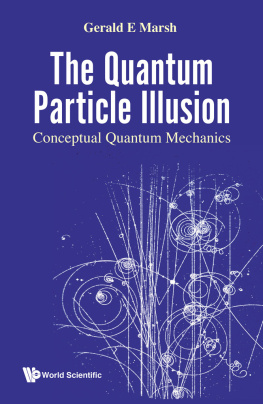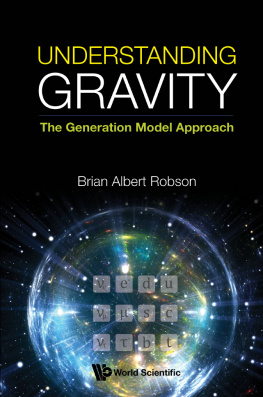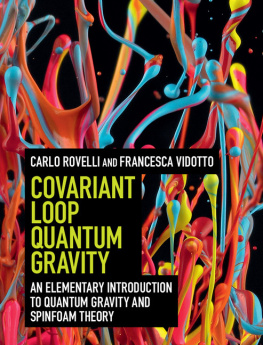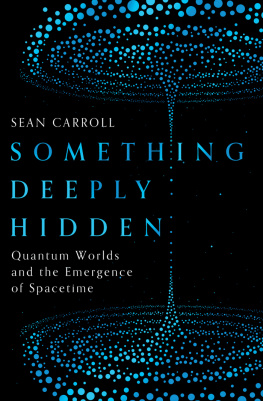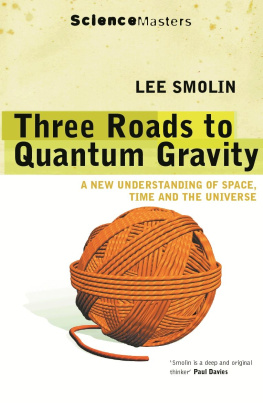Quantum Gravity in a Nutshell1
REVISED EDITION
BALUNGI FRANCIS
Copyright Balungi Francis 2018,2019, 2020
First published 2018
Copyright Bill Stone Services 2020
Balungi Francis asserts the moral right to be identified as the author of this work.
All rights reserved. Apart from any fair dealing for the purposes of research or private study or critism or review, no part of this publication may be reproduced, distributed, or transmitted in any form or by any means, including photocopying, recording, or other electronic or mechanical methods, or by any information storage and retrieval system without the prior written permission of the publisher.
Revised Edition: 2020
Cover by: znamide.
TABLE OF CONTENTS
Dedication
To my wife Wanyana Ritah,
My sons Odhran & Leander
Preface
There is a need for a book on a Quantum Theory of Gravity that is not directed at specialists but, rather, sets out the concepts underlying this subject for a broader scientific audience and conveys joy in their beauty. The author has written with this goal in mind, and has succeeded admirably. This wonderful and exciting book is optimal for physics graduate students and researchers. The physical explanations are exceedingly well written and integrated with formulas. Quantum Gravity is the next big thing and this book will help the reader understand and use the theory.
Authors Note
Our search for ultimate understandingthe Quantum Theory of Gravityhas long been the quest of such great scientists as Aristotle, Newton, Einstein, Hawking and many others, and is expected to transform science, providing clarity and understanding that is unknown today, ideally via one single overlooked principle in nature. So far, this quest has produced theories such as Special Relativity, General Relativity and Quantum Mechanics, and such recent proposals as "Dark Matter" and "Dark Energy" in cosmology. Yet these all suffer serious internal problems and compatibility issues with each other, introducing even more questions, mysteries and paradoxesand often even violations of our laws of physics upon closer examination. As a result, the Quantum Theory of Gravity continues to elude us, leaving a fractured and divided scientific community with no clear direction forward. This has also resulted in the mathematisation of physics which has resulted in the reduction of the cosmos to a mathematical entity, which has not only confused physicists but accounts for their worst and most distracting assertions. This book makes a first case for the latter, with clear discussions exposing the flaws in the above concepts and more, while stepping back to take a good look at the scientific legacy we have inherited.
We are probably asking the wrong questions at the moment, nevertheless it is impossible to resist the temptation to try. After all, the other fundamental forces except gravity fit very neatly with quantum mechanics.
Balungi Francis 2018
1.Solving Quantum Gravity
The development of a quantum theory of gravity began in 1899 with Max Plancks formulation of Planck scales of mass, time, and length. During this period, the theories of quantum mechanics, quantum field theory and general relativity had not yet been developed. This means that Planck himself had no idea about what he had just developed-behind the Black board. Planck was not aware of quantum gravity and what it would mean for physicists. But he had just coined in formula one of the starting point for the holy grail of physics.
After P.Bridgmans disapproval of Plancks units in 1922, Albert Einstein having published the General Relativity theory, a few months after its publication he noted that to the intra-atomic movement of electrons, atoms would have to radiate not only electromagnetic but also gravitational energy if only in tiny amounts, as this is hardly true in nature, it appears that quantum theory would have to modify not only Maxwellian electrodynamics, but also the new theory of gravitation. This showed Einsteins interest in the unification of Plancks quantum theory with his newly developed theory of Gravitation.
Then in 1933 came Bronsteins cGh-plan as we know it today. In his plan he argued a need for Quantum Gravity. In his own words he stated: After the relativistic quantum theory is created, the task will be to develop the next part of our scheme that is, to unify quantum theory (h), special relativity (c) and the theory of gravitation (G) into a single theory. Thus the theory of quantum gravity is expected to be able to provide a satisfactory description of the microstructure of space time at the so called Planck scales, at which all fundamental constants of the ingredient theories, c (speed of light), h ( Planck constant) and G ( Newtons constant), come together to form units of mass, length and time.
Therefore the need for the theory of quantum gravity is crucial in understanding nature, from the smallest to the biggest particle ever known in the universe. For example, we can describe the behavior of flowing water with the long- known classical theory of hydrodynamics, but if we advance to smaller and smaller scales and eventually come across individual atoms, it no longer applies. Then we need quantum physics just as a liquid consists of atoms Daniel Oriti in this case imagines space to be made up of tiny cells or atoms of space and a new theory of quantum gravity is required to describe them fully.
The aim of this book is to develop a theory capable of explaining the quantum behavior of the gravitational fields and thereafter explain the problems involving a combination of very high energy and very small dimensions of space such as, the behavior of Black holes and the study of the properties of the early universe.
For us to solve quantum gravity (QG), we need to address, understand and resolve in detail the problems brought about by the failure of the general theory of relativity (GR). Below I outline briefly where GR breaks down and later I resolve each of these problems with applications.
(1) General relativity fails to explain details near or beyond space-time singularities. That is, for high or infinite densities where matter is enclosed in a very small volume of space. Abhay Ashtekar says that; when you reach the singularity in general relativity, physics just stops, the equations break down
(2)General relativity fails to account for dark matter.
(3) General relativity also fails to be quantized.
Singularity Resolution in Quantum Gravity
The demand for consistency between a quantum description of matter and a geometric description of spacetime, as well as the appearance of singularities (where curvature length scales become microscopic), indicate the need for a full theory of quantum gravity. For example; for a full description of the interior of black holes, and of the very early universe, a theory is required in which gravity and the associated geometry of space-time are described in the language of quantum physics. Despite major efforts, no complete and consistent theory of quantum gravity is currently known, even though a number of promising candidates exist.
The first step towards the development of a quantum theory of gravity lies in studying the kind of physics behind black holes which are born when normal stars die or which were formed in regions of high energy density in the early universe. Black holes on the other hand, are completely collapsed stars that is, stars that could not find any means to hold back the inward pull of gravity and therefore collapse to a singularity.
This section is aimed at answering questions like; i) Do objects continually collapse to a singularity or there is a limiting distance below which the very notions of space and length cease to exist?








